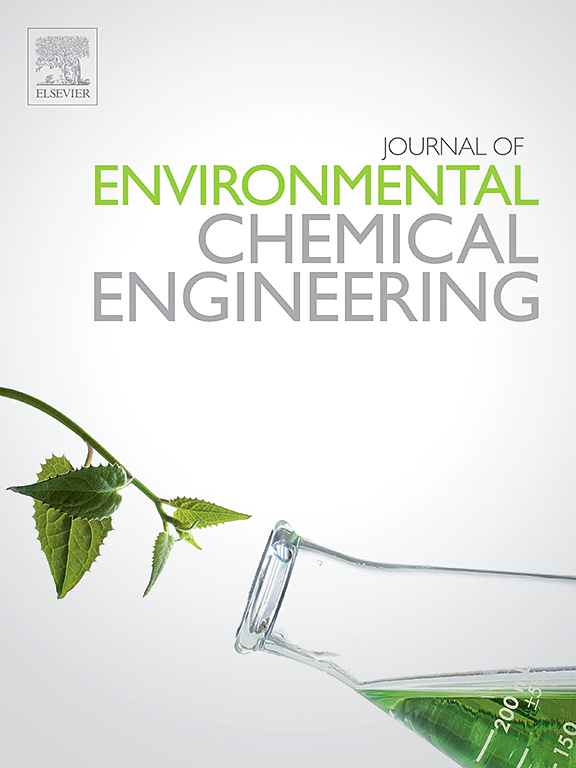氮改性石墨烯对N2/CH4混合物气体分离的研究
IF 7.2
2区 工程技术
Q1 ENGINEERING, CHEMICAL
引用次数: 0
摘要
掺杂是一种被广泛采用的调节石墨烯表面电子特性的方法。特别是,氮掺杂石墨烯已成为一种有前途的,具有高性能潜力的经济高效的吸附剂。在本研究中,采用大规范蒙特卡罗(GCMC)和分子动力学(MD)模拟研究了氮掺杂石墨烯(NDG)形成的狭缝状纳米孔中N2/CH4混合物在不同氮掺杂浓度和孔径下的吸附和扩散行为。结果表明,氮含量的增加提高了氮气/CH4的选择性和吸附能力。在5.6% %的NDG和6.2 Å %的NDG条件下,选择性达到5.86,其中NDG表现出明显的分子筛分特性。在298 K和500 atm下,N2吸收率超过0.006 mmol/m2,而CH4的吸附可以忽略不计。在较窄的孔隙中,更强的热力学相互作用和较小的动态直径共同作用有利于N2吸附,而在较宽的孔隙中(超过两个原子层),热力学因素占主导地位。值得注意的是,在1 atm下,CH4在NDG中的吸附量达到0.0094 mmol/m2,超过了N2(0.0091 mmol/m2),掺杂率为5.6 %,孔径为7.0 Å。平均力势(PMF)计算进一步揭示了分子传输的不同能量障碍,强调了孔隙化学和几何形状对扩散选择性的关键影响。自扩散系数随分子负载的变化而变化,氮掺杂对气体扩散的影响最小。这些发现强调了氮功能化石墨烯在N2/CH4高效分离方面的潜力,并为合理设计先进的碳基吸附剂提供了理论指导。本文章由计算机程序翻译,如有差异,请以英文原文为准。
Exploring the gas separation of N2/CH4 mixture on nitrogen-modified graphene
Doping represents a widely adopted approach to modulate the electronic characteristics of graphene surfaces. In particular, nitrogen-doped graphene has emerged as a promising, cost-effective adsorbent with high performance potential. In this study, Grand Canonical Monte Carlo (GCMC) and molecular dynamics (MD) simulations were employed to investigate the adsorption and diffusion behaviors of N2/CH4 mixtures within slit-shaped nanopores formed by graphic-N dopant graphene (NDG), with systematically varied nitrogen doping concentrations and pore widths. The results reveal that increasing nitrogen content enhances both the N2/CH4 selectivity and the adsorption capacity. A maximum selectivity of 5.86 was achieved at 5.6 % NDG with 6.2 Å, where the NDG exhibited pronounced molecular sieving characteristics. At 298 K and 500 atm, the N2 uptake exceeded 0.006 mmol/m2, while CH4 adsorption was negligible. At narrower pore widths, N2 adsorption was favored due to the combined effects of stronger thermodynamic interactions and smaller dynamic diameter, whereas in wider pores (beyond two atomic layers), thermodynamic factors dominated. Notably, at 1 atm, CH4 adsorption reached 0.0094 mmol/m2-surpassing N2 (0.0091 mmol/m2)-in NDG with 5.6 % doping and a 7.0 Å pore width. Potential of mean force (PMF) calculations further revealed distinct energy barriers for molecular transport, underscoring the critical influence of pore chemistry and geometry on diffusion selectivity. While the self-diffusion coefficient varied with molecular loading, the effect of nitrogen doping on gas diffusion was minimal. These findings underscore the potential of nitrogen-functionalized graphene for efficient N2/CH4 separation and provide theoretical guidance for the rational design of advanced carbon-based adsorbents.
求助全文
通过发布文献求助,成功后即可免费获取论文全文。
去求助
来源期刊

Journal of Environmental Chemical Engineering
Environmental Science-Pollution
CiteScore
11.40
自引率
6.50%
发文量
2017
审稿时长
27 days
期刊介绍:
The Journal of Environmental Chemical Engineering (JECE) serves as a platform for the dissemination of original and innovative research focusing on the advancement of environmentally-friendly, sustainable technologies. JECE emphasizes the transition towards a carbon-neutral circular economy and a self-sufficient bio-based economy. Topics covered include soil, water, wastewater, and air decontamination; pollution monitoring, prevention, and control; advanced analytics, sensors, impact and risk assessment methodologies in environmental chemical engineering; resource recovery (water, nutrients, materials, energy); industrial ecology; valorization of waste streams; waste management (including e-waste); climate-water-energy-food nexus; novel materials for environmental, chemical, and energy applications; sustainability and environmental safety; water digitalization, water data science, and machine learning; process integration and intensification; recent developments in green chemistry for synthesis, catalysis, and energy; and original research on contaminants of emerging concern, persistent chemicals, and priority substances, including microplastics, nanoplastics, nanomaterials, micropollutants, antimicrobial resistance genes, and emerging pathogens (viruses, bacteria, parasites) of environmental significance.
 求助内容:
求助内容: 应助结果提醒方式:
应助结果提醒方式:


